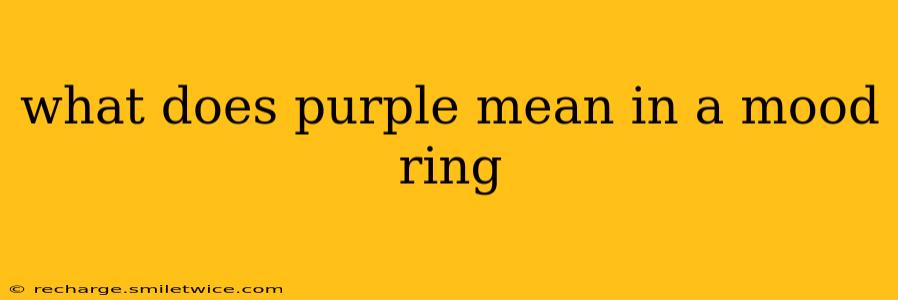Mood rings, those captivating pieces of jewelry that seemingly change color with your emotions, have intrigued people for decades. While the science behind their color-changing capabilities is debatable (they primarily react to temperature changes, not emotions directly), the meaning attributed to each color remains a fascinating aspect of their appeal. Today, we’ll delve into the meaning of purple in a mood ring and explore other frequently asked questions surrounding these intriguing accessories.
What Does Purple Mean on a Mood Ring?
Generally, purple on a mood ring is associated with independence and creativity. It suggests a period of self-reflection and perhaps a touch of mystery surrounding your current emotional state. Some interpretations even link purple to a balance between passion and tranquility, signifying a time of calm contemplation yet with underlying creative energy. It's important to remember that these interpretations are subjective and differ slightly across various sources.
What Other Colors Are There on a Mood Ring and What Do They Mean?
Mood rings typically display a range of colors, each with its own associated meaning. These meanings can vary slightly depending on the source, but here's a common interpretation:
- Black: Stress, tension, or negativity.
- Dark Blue/Indigo: Sadness, nervousness, or insecurity.
- Blue: Calmness, contentment, or peace.
- Green: Nervousness, anxiety, or stress.
- Yellow-Green: Indecisiveness or feeling overwhelmed.
- Yellow: Joy, happiness, or excitement.
- Orange: Energy, enthusiasm, or sociability.
- Red: Passion, excitement, or arousal.
- Pink/Lavender: Relaxed, peaceful, or romantic mood.
- Purple: Independence, creativity, balance between passion and tranquility.
- Brown: Fatigue, tiredness, or ill health.
How Accurate Are Mood Rings?
It's crucial to understand that mood rings don't actually detect emotions directly. Their color changes are primarily a result of variations in skin temperature. Your body temperature fluctuates due to a multitude of factors, including physical activity, stress, and even the ambient temperature. While a color change might correlate with a particular emotion at times, it's not a precise or reliable indicator of your exact emotional state. Consider them more as fun novelty items rather than scientific emotion detectors.
Do Mood Rings Really Work?
The effectiveness of mood rings is largely a matter of belief. Many people enjoy them for their aesthetic appeal and the fun of associating colors with potential emotional states. However, from a scientific standpoint, their accuracy is questionable. Their color-changing mechanism is thermochromic, meaning it responds to temperature changes, not emotions directly.
Why Does My Mood Ring Change Color?
As previously mentioned, the color change in mood rings is primarily due to thermochromic liquid crystals embedded within the stone. These crystals alter their molecular structure in response to temperature variations, resulting in visible color shifts. Factors like environmental temperature, physical activity, and even your blood flow can influence your skin temperature, thus causing the color of the ring to change.
Are There Different Types of Mood Rings?
Yes, mood rings come in various styles and designs. You can find them in different metal settings, with different-sized stones, and incorporating various gemstones or materials alongside the thermochromic element. The basic principle remains the same, though – the color change is linked to temperature variations.
In conclusion, while purple in a mood ring generally signifies independence and creativity, it's essential to remember the limitations of these fascinating but ultimately unscientific pieces of jewelry. Enjoy them for their charm and the fun associations, but don't rely on them for accurate emotional readings.
